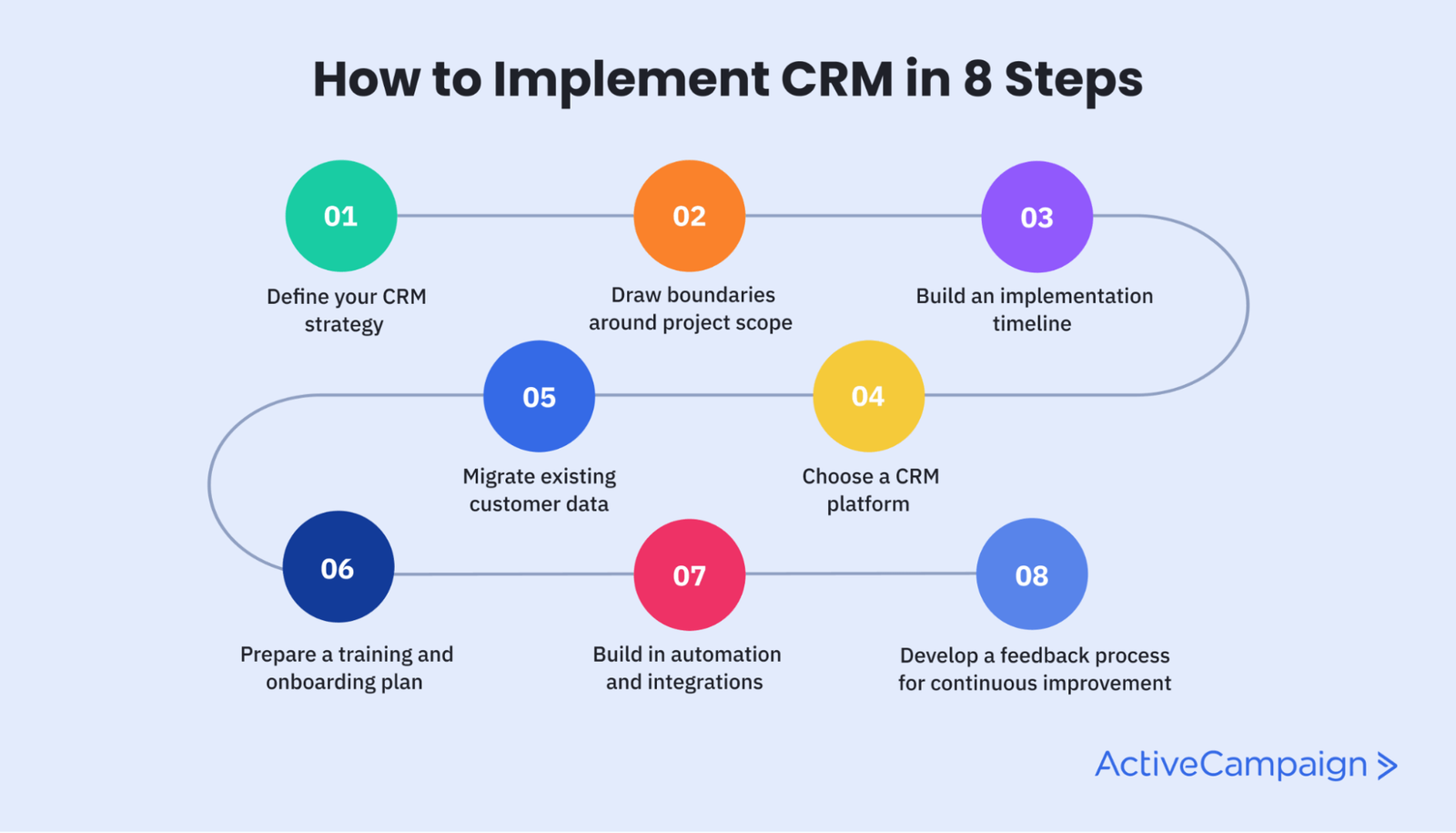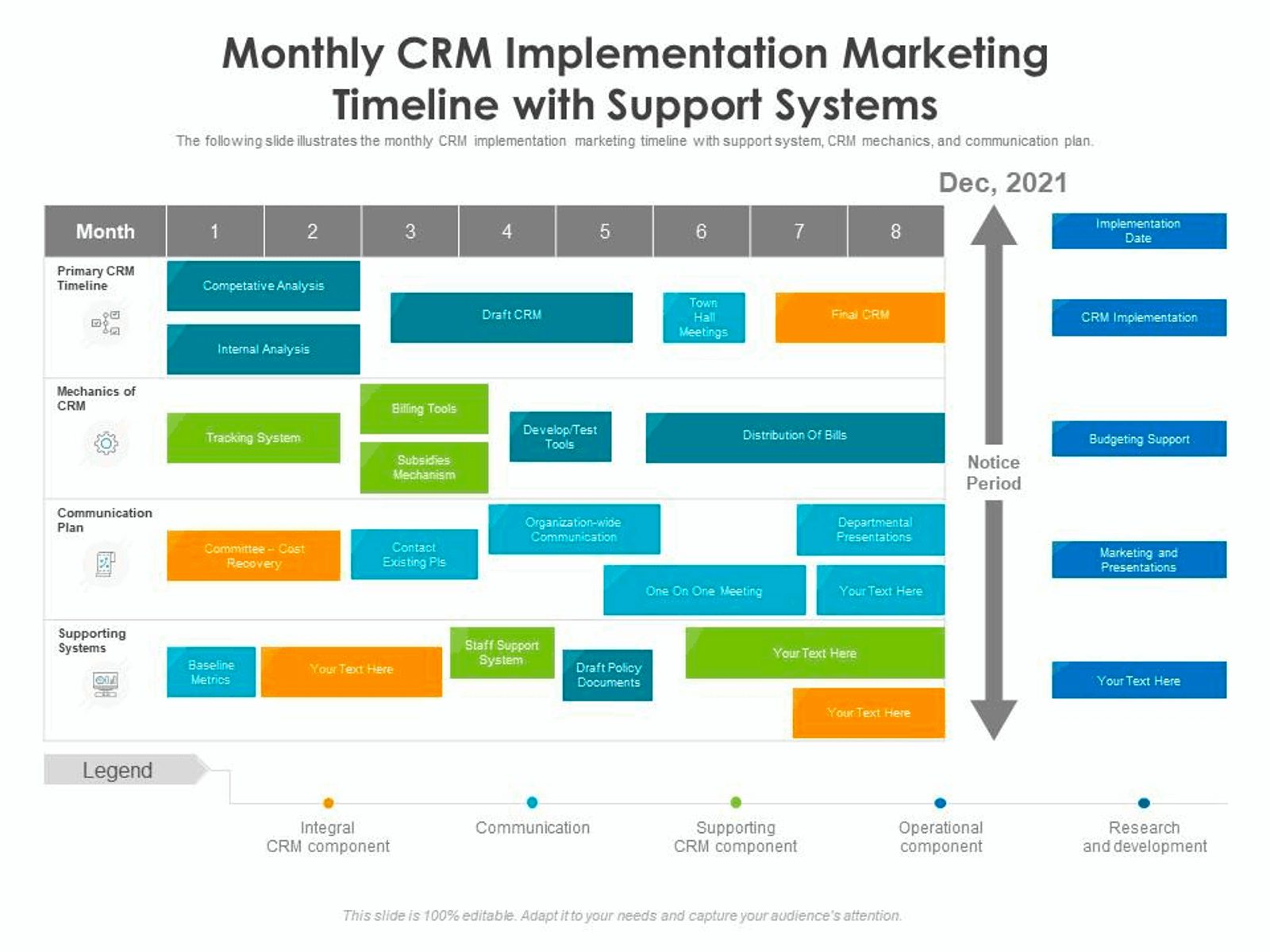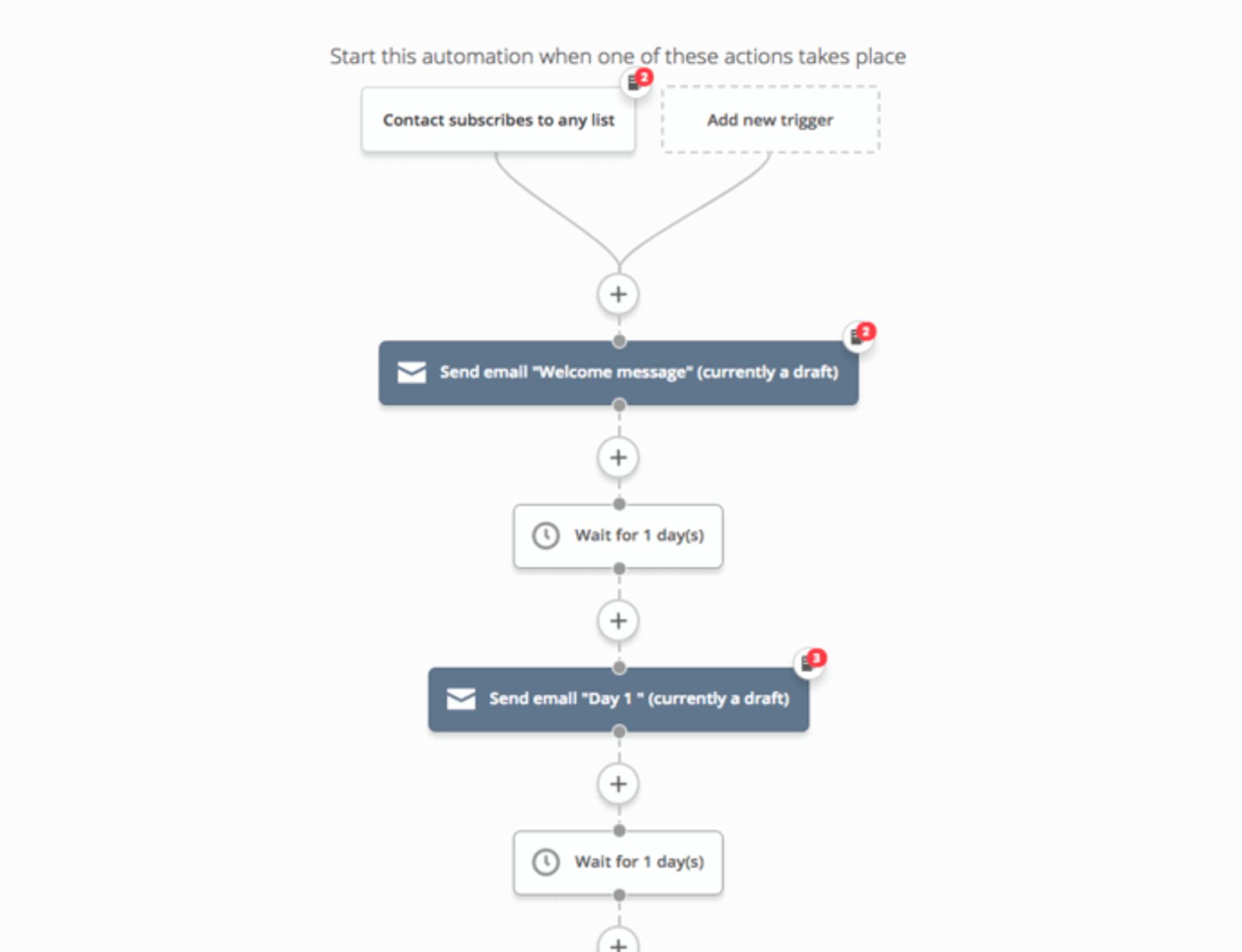Using a CRM (customer relationship management) platform is pretty much standard practice—91% of businesses with more than 10 employees use one.
But what’s less common is building a comprehensive CRM implementation process.
Commonly, business leaders sign up for an account with their preferred CRM platform and then throw access to their department leaders (sales, marketing, success) and let them figure it out.
The result?
Disconnected relationship management processes, poor data governance, and altogether inefficient use of the system.
In this article, we’ll outline the 8 critical steps to designing a successful CRM rollout, so you can avoid these mistakes and get working efficiently from the get-go.
But first, let’s clarify some things about customer relationship management.
Table of Contents
CRM implementation: the basics
The term “CRM,” for better or worse, has a couple of different meanings.
The acronym stands for Customer Relationship Management. So, technically, CRM is the business process that focuses on improving relationships with prospective and current customers to retain and drive new revenue.
Hence, CRM as a business process is used for sales, marketing, support, and customer success.
But here’s where things get tricky.
CRM has become such a ubiquitous and crucial business undertaking that a whole sector of software platforms has emerged, called CRM platforms, but now widely referred to as “CRMs” or “the CRM,” which are used to manage existing relationships and nurture sales opportunities.

Here’s the key:
If someone says “a CRM,” “the CRM,” “our CRM,” or any other phrase that refers to CRM as a “thing,” then they’re talking about a CRM software platform.
If they refer to CRM in the context of “CRM processes” or “CRM leaders,” they’re referring to the overarching idea of managing customer relationships.
What is the purpose of CRM?
The purpose of CRM (the process and the resultant software tech) is to improve the quality of customer relationships.
Businesses achieve this through several initiatives, such as:
- Improved access to customer data (so they can better serve individuals on a personalized level but also apply this information to new client acquisition)
- Better communication cadences (through scheduling, reminders, and automation)
- Brand consistency (communications can be templated and automated)
The overarching idea behind customer relationship management is simple:
If you can improve the relationship between your brand and your customers, you’ll keep customers for longer. They’ll spend more, be more likely to refer friends, family, and colleagues, and help you grow revenue.
Is CRM a tool or process?
Well, both.
Customer relationship management is a broad business practice that focuses on developing the brand-customer relationship.
It is not, in itself, a process, though individual organizations will develop internal processes within a wider CRM practice.
But CRMs are also tools if we’re referring to CRM software platforms. However, these software tools don’t replace customer relationship management processes; they support them.
What is the CRM lifecycle?
The CRM lifecycle is a concept that refers to the stages a given customer moves through and how your company approaches managing the customer-brand relationship based on the stage they’re at.
There are 5 key stages in the typical CRM life cycle model, aligning closely with the typical sales cycle:
- Reach
- Acquisition
- Conversion
- Retention
- Loyalty
Marketing is responsible for the reach stage (running ads and distributing content to reach potential clients). They work closely with sales teams during acquisition (turning potential customers into leads).
From there, sales nurtures the relationship through to the conversion stage (where the lead becomes a customer) and then hands the customer over to the service and success teams to continue growing that relationship.
Their goal is to keep the customer on board (through customer retention and customer satisfaction initiatives) and delight them so much that they refer friends, family, or colleagues (which we consider the loyalty stage of the life cycle).

We visualize the CRM lifecycle as an infinite loop, as loyal customers are those who become advocates for our brand. They refer other customers and become part of the “reach” stages for those new customers.
How to implement CRM in 8 steps
With those CRM basics out of the way, how can your organization put together a successful CRM implementation strategy to ensure the success of your new undertaking?

1. Define your CRM strategy
Like any good business undertaking, the first step in CRM implementation is understanding (and communicating) your core business goals.
Ask:
- What problem(s) are we trying to solve by implementing the CRM process?
- How are we managing these problems now?
- What are the implications if we don’t solve them? And if we do?
- What exactly needs to change in our organization?
- What results are we expecting to see post-implementation?
- What is our timeline for seeing these results, and how will we measure that success?
Build out your strategy with our free CRM template!
2. Draw boundaries around the project scope
New business projects tend to grow in scope sneakily.
Project managers call this phenomenon “scope creep,” where, over time, new initiatives are slowly added into the initial implementation method, to a point where the project is overwhelmingly large and takes far longer to complete than planned.
The best practice for avoiding scope creep is to define the boundaries of your undertaking from the get-go clearly.
Detail:
- Who is the project manager?
- What other stakeholders exist as part of the implementation team? What is their role in the project?
- What are the goals of the project (referring to what you covered in step one)?
- What exactly are the initiatives that will be completed in this project?
- What potential initiatives need to be noted as “out of scope?”
Then, define a process for dealing with new ideas that may be out of scope (because they will pop up).
How will you determine whether it's crucial to include these in the existing scope or define them as “outside of scope” or “future project?”
3. Build an implementation timeline
With the scope defined, your next step is building an implementation timeline. Choosing a single deadline date for project completion will be insufficient here, you will need project scheduling tools to break up the project into smaller time frames.
Instead, break down your CRM implementation process into digestible chunks that make sense from practical and sequential perspectives.
For example, your CRM implementation plan might include stages such as:
- Performing an internal analysis of business process
- Assessing various CRM software options
- Understanding required software integrations
- Consulting with business unit leaders (e.g., the sales manager or customer support reps)
- Preparing a cost analysis and approving budgets
- CRM migration
- User training and development with core team members

Once you’ve built out the key stages in the CRM implementation process, set appropriate due dates, define dependencies (where 1 stage is dependent on the completion of a previous, for example, the budget needs to be prepared before it can be approved), and map the timeline out visually.
4. Choose a CRM platform
Now it's software time.
There are a bunch of great CRM software platforms out there. Many of them share the same basic features, but each caters to slightly different audiences, needs and requirements, and business stages.
Across the board, however, essential features to prioritize include:
- Automation capabilities
- Integrations with other software packages
- Data security
- Quality of customer support
- Availability of self-help resources
- Scalability and ease of use
Fast & Easy CRM Implementation
5. Migrate existing customer data
Once you’ve decided on an appropriate CRM solution, you will need to set it up and get all of your existing customer information in there.
That data might come from a previous CRM platform, lead management tool, a spreadsheet (or series thereof), or a previous customer information management platform.
Ideally, you’ll work with your CRM provider to migrate this information, though that will depend on their offering and ability to migrate data from your current platform.
Make sure to build this process into your timeline (and give yourself a little extra buffer time, as data migration can be a headache, especially if you’re managing it internally). Strong data governance is crucial to a successful CRM implementation.
6. Prepare a training and onboarding plan
Gaining team buy-in on the new CRM project can prove challenging, but it will be especially difficult if employees are unclear on how to use the thing.
In an ideal world, your CRM software provider can provide onboarding and training. However, this isn’t offered by all providers and may be unrealistic for large companies with hundreds of employees.
In this case, building a comprehensive internal onboarding and training plan is critical to achieving CRM end-user adoption.
Rolling out CRM usage in stages can be a valuable strategy. You can do this by territory (e.g., starting with North American teams before rolling out to EMEA and onward) or by team (e.g., starting with sales, then incorporating success, then marketing).
In any case, clearly define a problem-solving process, and build a workplace wiki or document storage solution for CRM-based resources (for example, a guide and video on “How to add a new account in our CRM”).
7. Build in automations and integrations
Two of the most powerful features offered by today’s CRM platforms are the ability to automate manual work (for instance, touchpoints in the sales process) and to integrate with the other tools you’re already using (like email marketing tools you use to nurture prospects throughout the customer journey).

Work with your support and sales reps to understand the tasks they complete regularly and consult with your CRM provider to determine what can be automated.
For example, if your sales team operates a 7-step phone call and email cadence, you can set that cadence up in your CRM with automated call reminders and email sends.
8. Develop a feedback process for continuous improvement
Lastly, it's important to set up a system for capturing feedback from each team member post-rollout.
An easy way would be to set up an anonymous form (perhaps in your shiny new CRM platform) where employees can share their thoughts on the implementation process and how the new CRM impacts their work life.
Conclusion
Following these 8 steps will help you ensure a successful implementation project.
If you want to work a bit faster, you can skip step 4 (choosing a CRM platform) and jump straight into ActiveCampaign. Try us out today with a free 14-day trial.







